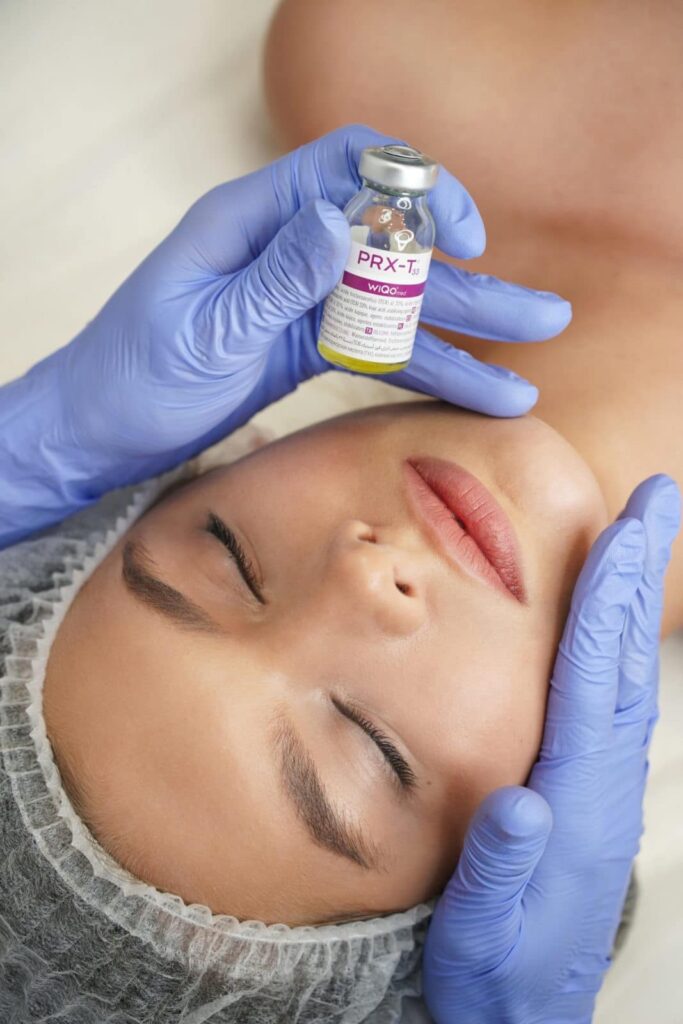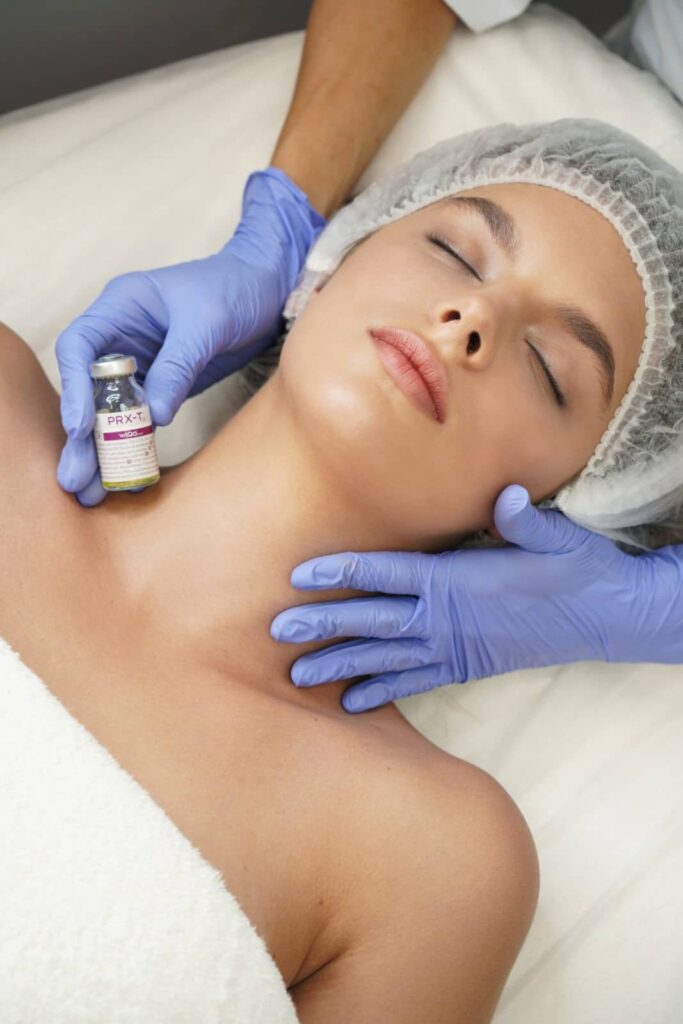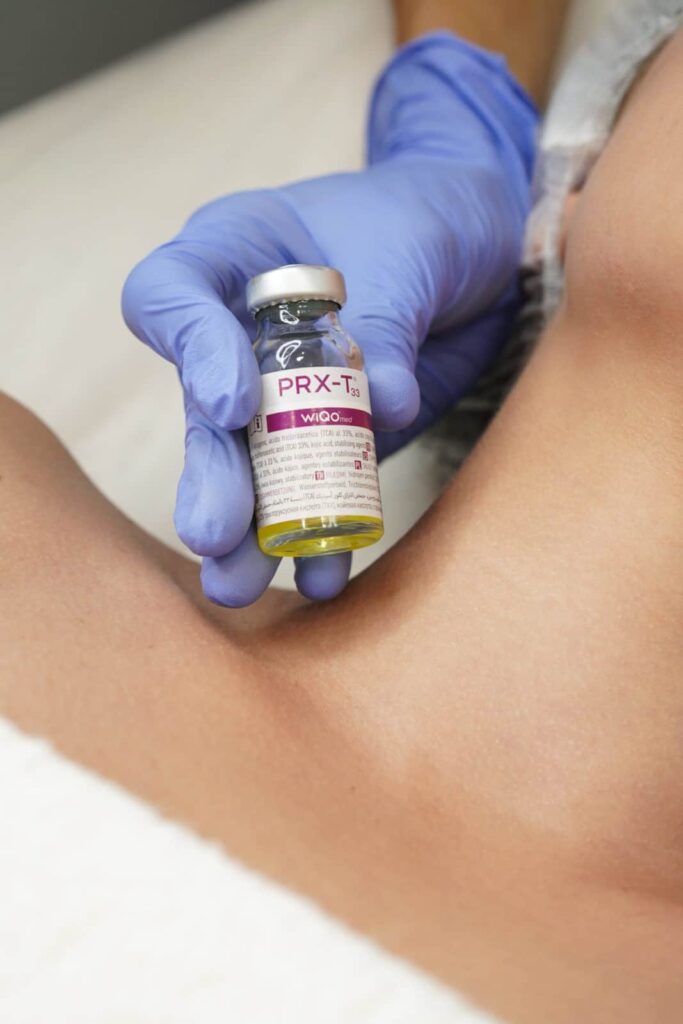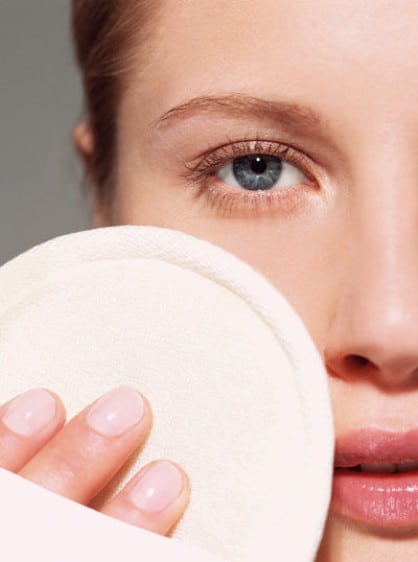Peeling
For many years, one of the most sought-after services in beauty salons has been peeling, a procedure aimed at cleansing the skin. Experienced cosmetologists at the PIED-DE-POULE salon are ready to offer various peeling options, each with its own advantages. To choose the most suitable method of care, we take into account the condition and individual characteristics of the skin, the preferences of our clients, and the expected results.

The Purpose of Peeling
The purpose of peeling is the complete or partial removal (exfoliation) of the outer layer of skin, and if necessary, layers below it. By eliminating dead cells, it stimulates the accelerated regeneration (renewal) of cells. As a result, you will see fresh, radiant, rejuvenated skin in the mirror. In addition, peeling also allows for the correction of some aesthetic defects.
Here is a partial list of problems for which the procedure is recommended:
- Hyperkeratosis
- Wrinkles
- Uneven skin tone
- Pigmentation
- Age spots
- Stretch marks
- Acne and post-acne marks
- Photoaging
- Large pores, and more.

Types of Peeling
The list of skin cleansing methods is quite diverse; peels differ in the method and depth of skin penetration.
- In mechanical peeling, abrasive particles such as scrubs are used to remove impurities and dead cells. These preparations may contain coral particles or microcrystals of aluminum oxide and other exfoliants.
- Chemical peeling uses acid and alkali compounds instead of abrasives. When the skin comes into contact with chemical agents, dead cells dissolve, and intercellular connections are disrupted.
- Ultrasound peeling involves exfoliation of dead skin cells through the action of ultrasound waves (requiring a specific device). Another option for mechanical exfoliation is laser peeling, where the skin is exposed to a laser beam.
Surface cleansing involves cleaning at the level of the outermost layer of skin. This procedure helps in the treatment of acne, enlarged pores, and hyperpigmentation. It can also be performed as a preparatory step before other cosmetic procedures, such as dermabrasion.
Medium peeling affects not only the outer layer of the skin but also the living cells of the epidermis down to the papillary layer of the dermis. It is an effective method for treating oily skin and helps correct irregularities in skin texture, as well as smooth out scars. This method is also used when unwanted signs of aging appear, such as decreased skin elasticity and wrinkles.
The most complex procedure is deep peeling, which targets the papillary layer of the dermis. Deep exfoliation provides rejuvenation and lifting effects but can be quite traumatic.
IMPORTANT! Peeling always involves tissue damage, so it is recommended to perform this procedure in a salon under the supervision of an experienced specialist. This is the only way to achieve the desired result and avoid complications such as burns, infections, and scarring.

Carbon Peeling
Peels are also classified based on the composition used. Typically, the primary element of the product is included in the procedure's name. Today, carbon peeling, also known as carbon dioxide or carboxy peeling, is well-known.
This procedure generally takes up to 1 hour and is conducted using a laser. In the first stage, a gel containing finely dispersed charcoal is applied to the skin. The cleansing composition penetrates the skin, and laser beams are directed onto the treated areas. As the laser heats up, it not only removes dead cells but also actively stimulates collagen and elastin production in the deep layers of the skin. Carbon peeling is highly effective for:
- Enlarged pores and comedones
- Post-acne issues
- Oily skin
- Hyperpigmentation
- Dull skin tone
- Wrinkles.
Carbon peeling has many advantages. It is a painless procedure that requires minimal recovery time and rarely causes complications (increased peeling may occur in sensitive skin). The treatment can be done at any time of the year. As customer reviews show, the price of peeling is fully justified by excellent results.

Almond Peel
This procedure involves the treatment of the superficial layers of the skin while also stimulating the deeper layers. It is a delicate and gentle manipulation that allows for:
- Thoroughly loosening the outermost layer of skin.
- Clearing the ducts of glands.
- Improving tissue oxygenation and nourishment.
- Stimulating collagen production.
One of the advantages of almond peeling is its versatility — it can be performed at any time of the year and is suitable for people with different skin types, including very sensitive skin.
Clients at our salon who opt for this service report reduced oily shine and pigmentation, improved skin texture and color, and increased skin elasticity. Indications for the procedure include seborrheic dermatitis, acne rash, and premature aging.
As the name suggests, the active ingredient in this case is phenoxyglycolic acid, also known as almond acid. During the cosmetic session, the skin is treated with professional products containing acid concentrations of at least 20%. The formulation is left on the skin for approximately 20 minutes, after which a neutralizing agent is applied. The final step involves moisturizing and soothing the skin. The final cost depends on the selected product, the recommended number of procedures, and any additional services.

Contraindications for the Procedure
The specialists at the PIED-DE-POULE salon carefully select the peeling method for each patient. We use sterile instruments and trusted formulations from well-known manufacturers. Depending on individual characteristics, each client is offered a specific method, product, concentration, and skincare regimen. Each type of peeling has its own list of contraindications, which is communicated to the client.
Common restrictions include:
- Inflammatory and allergic skin conditions.
- Certain chronic skin conditions.
- Herpes.
- Skin injuries (scratches).
- Tendency to develop scars.
- Epilepsy.
- Pregnancy.
- Intolerance to specific components of working formulations (for chemical peeling).
We also draw your attention to the fact that some types of procedures are not recommended during the summer season because exposure to sunlight can lead to skin pigmentation.
Customer reviews
-
I adore PDP. I especially like hairdresser Yana who works in a salon located on Shota Rustaveli Street. After her great work my hair looks stunning and shiny. This is the best salon for me in all respects. There is always a cool atmosphere and friendly beauty experts.
-
I like styling and makeup in PDP. There is always a great atmosphere, I feel as at home. I also get a lot of compliments concerning my styling and makeup on different events. Of course, I always recommend PIED-DE-POULE beauty salon to all of my friends.
-
I have been regularly visiting PIED-DE-POULE for BRAE hair care for more than a year. Thanks to this procedure I grew health dreamed length of hair. I do styling more often than care. I like that different beauty experts work with me but I always get the same professional services.
-
I have been visiting this lovely beauty salon for a year already and I am extremely satisfied with service quality. These are the procedures I do on a regular basis! All the specialists always follow my requests! I especially adore a beauty expert whose name’s Maxim. He is just wonderful specialist! I am extremely thankful for the service quality.
-
I wish to express my gratitude to PIED-DE-POULE! The staff took into account all my wishes concerning the choice of hair color. The result was just wonderful! Also, I had a facial peeling and pedicure – all in all, I liked the service!
-
I have been a regular customer of the network of PIED-DE-POULE beauty salons for more than two years. I visit PDP on Shota Rustaveli most often as far as its location is convenient for me. Additionally, my favorite makeup artist, Ira, works there.
-
I visited PDP for the Balmain hair treatment (we tried to solve the problem of dry hair after lighting into blonde). Hairdresser’s name is Iia. She has told me about hair care and helped me to choose right products for my hair. I am really satisfied with her work. This “ritual” is my chance to grow length again after being blonde and having a bob).
-
PIED-DE-POULE beauty salon has been one of my favorite places in Kyiv for many years. I always choose and visit only this salon and I do not go to other places. There is always friendly atmosphere and professionalism of high-level. What is more, there is one significant point: if you come to PDP and you are hungry, the staff can offer you a menu with delicious and healthy food which can be delivered really fast!
-
I have been visiting PIED-DE-POULE for two years already and I am thrilled with the quality of the procedures, all the staff and communication. I like the possibility to always choose the most suitable time for me. Also, thanks to the salon, I never miss any new product of beauty industry and especially products for hair care as far as I enjoy them much!